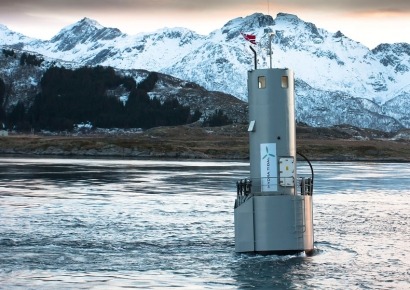
Harald Østerberg, Straum’s CEO, has it clear, “through consolidation we gather unique expertise and financial strength to break through in the global market. We see clear synergies connected to technology development and Straum”.
Østerberg’s new company draws on Norwegian offshore and hydropower know-how and has the backing of the privately-owned Norwegian investment company, NLI Utvikling, and hopes to use both to penetrate the growing offshore wind, wave and tidal energy markets.
“Norway has a strong history of developing world class offshore and hydropower technologies. This is a unique platform to develop marine renewable energy systems from, and a competitive advantage we believe now is materialized in Straum,” says Østerberg.
Today Straumis located with four offices in Norway, although the company plans to establish a local presence in key markets such as US, UK and China within the next year. Straum is working hard to develop and market three main technologies.
Floating offshore wind
WindSea FloaterTM is a new concept for offshore wind turbine platforms which consists of a floating platform supporting three wind mills. The configuration of the platform is a semi-submersible vessel with three corner columns. Each column supports one wind turbine. The semi-submersible vessel is moored to the sea bottom with the mooring lines connected to a turret at the vessel geometric centre. “This configuration allows the vessel to rotate. The vessel is therefore always able to orient the turbines optimally towards the incoming wind,” explains the company.
Today, offshore wind turbine farms are deployed in fixed (to the seabed), monopile, jacket or gravity base configurations. The bottom fixed foundation concept for offshore windmills can only be installed in sea depths of 40-60 m. maximum, whereas some floating platforms require a minimum water depth of 110-130 m. As the WindSea FloaterTM concept requires only approximately 45m water, it can be installed in water depths ranging from 45m up to several hundred metres.
“In theory there are no limits to the depth at which WindSea FloaterTM could be installed. Thus, the main advantages of the WindSea floating platform are: location flexibility (floating platform in 45-700+ m. water depths), on-shore fabrication (can be constructed in a ship yard), "plug and play installation (easy connection to the mooring system) and on-shore (or on site) maintenance,” explains Straum.
Capturing wave energy
Second in its portfolio is the OWC Power wave converter, based on the Oscillating Water Column principle (OWC).
In a wave power converter based on the OWC principle, the waves push a water column up and down an oscillation chamber. The oscillating water column pushes air in front of it causing air to flow back and forth through an air turbine. The turbine rotates in the same direction independent of the direction of the airflow. Thereby the oscillating wave movement is converted into a continuous rotating motion, which drives a standard electric generator.
According to the company, OWC Power’s system has fewer moving parts than other similar concepts. The energy production is a continuous process where the so called wells-turbine rotates in the same direction independent of wave movements.
“The concept has been tested, and the basic working principle has been proven. Optimization of efficiency and power output is continuously on the agenda. Robust design with good availability and low maintenance needs are well known requirements in the power generation business and these requirements will be emphasized in the further development of the OWC Power concept,” the company says.
Hydra Tidal
Lastly, Straum is working to develop its Hydra Tidal floating ocean energy system; “one of a very few full scale tidal energy plants built and deployed in the world”. In November of 2010, its 1.5-MW unit “Morild II” was installed on site in the Lofoten Islands in the north of Norway, for a two year trial period. The plant has made trial-feeds to the local grid, and following a current upgrade of the prototype it will be tested further, leading towards a full verification and evaluation of the technology.
“The floating solution is designed to effectively exploit both ocean and tidal currents through optimum resource access. This is enabled by a patented mooring and anchoring system which basically makes the plant water depth independent. The Hydra Tidal™ construction is based on the same principles as horizontal axis wind turbines, with a concept design that supports remote operation, towing, docking, installation, as well as easy access for low cost O&M - all important factors in managing cost of marine operations and risk issues for ocean energy developers,” says the company.
[Inset: Hydra Tidal energy converter. Courtesy of Straum.]
For additional information:

